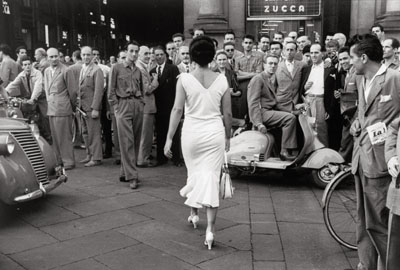
(Italians turn their heads)
Gelatin-silver print, 30,7 x 40,5 cm
© Mario De Biasi
NEOREALISMO - Italy's New Image 1932-1960
Die neue Fotografie in Italien 1932-1960
Aldo Beltrame » Gianni Berengo Gardin » Carlo Bevilacqua » Giuliano Borghesan » Gianni Borghesan » Piergiorgio Branzi » Stefano Bricarelli » Giuseppe Bruno » Alfredo Camisa » Mario Carbone » Mario Carrieri » Enrico Cattaneo » Mario Cattaneo » Giuseppe Cavalli » Cesare Colombo » Luigi Crocenzi » Mario De Biasi » Mario Dondero » Pietro Donzelli » Ernesto Fantozzi » Stanislao Farri » Luciano Ferri » Mario Finocchiaro » Mario Giacomelli » Giancolombo » Alberto Lattuada » Giuseppe Leone » Nino Migliori » Riccardo Moncalvo » Paolo Monti » Ugo Mulas » Alessandro Novaro » Enrico Pasquali » Federico Patellani » Tino Petrelli » Franco Pinna » Stefano Robino » Fulvio Roiter » Chiara Samugheo » Tazio Secchiaroli » Enzo Sellerio » Lamberti Sorrentino » Luigi Veronesi » Pablo Volta » Italo Zannier » Arturo Zavattini »
Exhibition: 1 Sep – 18 Nov 2007
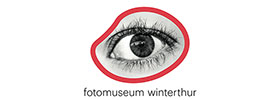
Fotomuseum Winterthur
Grüzenstr. 44+45
8400 Winterthur
+41 (0)52-2341060
info@fotomuseum.ch
www.fotomuseum.ch
Tue, Thu, Fri 11-17; Wed 11-20; Sat-Sun 11-18
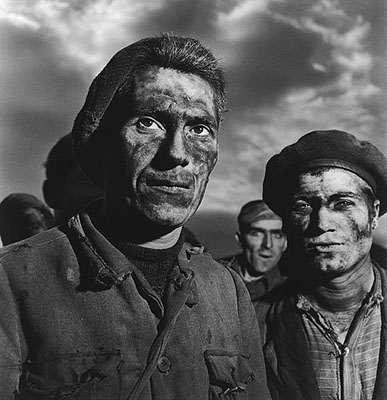
Minatori di Carbonia, Sardinia 1950
(Miners of Carbonia)
Gelatin-silver print, 51 x 41,5 cm
© Archivio Patellani
Neorealism, mainly associated with the films by Visconti, De Sica and Rossellini, was a heartfelt artistic response to the transformation of Italy in the course of the twentieth century. With the demise of Fascism, which had harnessed the mass media of photography and film for its own purposes and moulded a new aesthetic of reality, Neorealism surged to the fore. The newfound freedom of opinion and the need to forge a new Italian identity fuelled a feverish interest in documenting reality and exploring what it meant to be Italian. One after another, illustrated magazines were launched and photographic-ethnographic field studies undertaken on life in the country's remote communities. Society needed photographs that captured all aspects of life in every situation. The exhibition and accompanying publication bring together some 250 photographs by 75 different photographers, making this the first major in-depth presentation of photographic Neorealism. Six authors chart the development of Neorealism from its inception to the late 1950s, shedding light on the reciprocal influences of photography, film and literature. The exhibition is curated by Enrica Viganò. It has been organised in collaboration with SEPIF s.a.s. (‹Studi e Progetti in Fotografia›), Turin, and La Fábrica, Madrid. With additional support by Istituto Italiano di Cultura, Zurich. Main sponsor of the exhibition and the book: UBS AG Publication: "NeoRealismo – Die neue Fotografie in Italien 1932-1960". Ed. Enrica Viganò, published at Fotomuseum Winterthur and Christoph Merian Verlag. With texts by Enrica Viganò, Giuseppe Pinna, Gian Piero Brunetta and Bruno Falcetto, and an extensive lexicon put together by Enrico Manfredini and a chronology by Fabio Amodeo. 340 pages, 250 Duplex-illustrations of 75 photographers, format 24,5 x 30 cm, hardcover, bound. Price: CHF 69.-
Fotomuseum Winterthur (Halle und Galerie) Der Neorealismus, vor allem bekannt durch die Filme von Rossellini, De Sica oder Visconti, war eine intensive künstlerische Reaktion auf die grossen Transformationen Italiens im 20. Jahrhundert. Der Faschismus hatte Fotografie und Film als Massenmedien etabliert, nutzte sie für seine Zwecke und schuf eine klar umrissene Ästhetik der Abbil dung von Realität. Nach seinem Zusammenbruch gelang dem Neorealismus der Durch bruch. Die wiedergewonnene Meinungsfreiheit und die Notwendigkeit, sich als Italiener eine neue Identität zu schaffen, heizten das fieberhafte Interesse am Dokumentarischen, am Abbilden der Wirklichkeit und an der Erkundung des Landes an. In rascher Folge er schienen illustrierte Zeitschriften, die fotografisch-ethnografische Feldforschung begann, man wollte erfahren, wie man in den abgelegenen Provinzen lebt. Die Gesellschaft brauchte Fotografen, die das Menschliche in all seinen Gegensätzen und an allen Schauplätzen festhielten. Die Ausstellung präsentiert rund 230 Werke von 75 Fotografen und stellt erstmals den fotografischen Neorealismus ausführlich vor. Im begleitenden Buch, das im Christoph Merian Verlag erscheint, zeichnen sechs Autorinnen und Autoren den Weg des Neorealismus von den Anfängen bis in die späten fünfziger Jahre nach und machen die Wechselwirkungen zwischen Fotografie, Film und Literatur sichtbar. Kuratorin der Ausstellung ist Enrica Viganò. Die Ausstellung wurde in Zusammenarbeit mit SEPIF, Turin, und La Fábrica, Madrid, organisiert. Mit zusätzlicher Unterstützung vom Istituto Italiano di Cultura, Zürich Hauptsponsor von Ausstellung und Buch: UBS AG Publikation: "NeoRealismo – Die neue Fotografie in Italien 1932-1960". Hg. Enrica Viganò, erscheint im Fotomuseum Winterthur und Christoph Merian Verlag. Mit Texten von Enrica Viganò, Giuseppe Pinna, Gian Piero Brunetta und Bruno Falcetto, sowie einem umfangreichen Kurzlexikon zusammengestellt von Enrico Manfredini und einer Zeittafel von Fabio Amodeo. 340 Seiten, 250 Duplex-Abbildungen von 75 Fotografen, Format 24,5 x 30 cm, Hardcover gebunden. Preis CHF 69.-
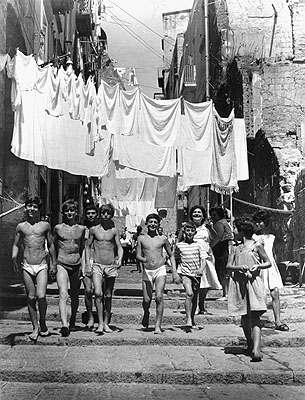
‹Vicoli a Napoli›, Naples 1951-1958
(‹Backstreets of Naples›)
Gelatin-silver print, 40,1 x 31,5 cm
© Eredi Mario Cattaneo
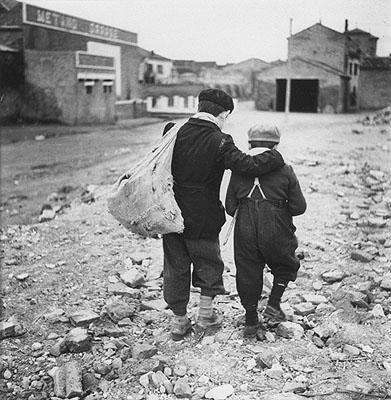
Bambini, periferia di Comacchio, Emilia-Romagna 1955
(Children on the outskirts of Comacchio)
Gelatin-silver print, 41,3 x 31 cm
© Eredi Enrico Pasquali